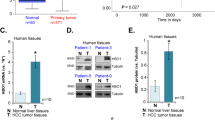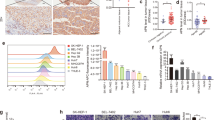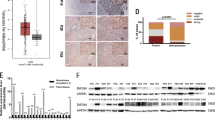Abstract
Lysosomal-associated protein transmembrane-4 beta (LAPTM4B), a novel gene upregulated in hepatocellular carcinoma (HCC), was cloned using fluorescence differential display, RACE, and RT–PCR. It contains seven exons and encodes a 35-kDa protein with four putative transmembrane regions. Both the N- and C-termini of the protein are proline-rich, and may serve as potential ligands for the SH3 domain. Immunohistochemical analysis localized the protein predominantly to intracellular membranes. Northern blot showed that the LAPTM4B mRNAs were remarkably upregulated in HCC (87.3%) and correlated inversely with differentiation status. LAPTM4B was also overexpressed in many HCC-derived cell lines. It was also highly expressed in fetal livers and certain adult normal tissues including the heart, skeletal muscle, testis, and ovary. Promoter function assays showed a distinct difference in the gene's activities between BEL7402 and HLE cell lines, suggesting that the transcription factors responsible for regulation of the gene in the two cell lines are different, and that possible negative regulatory cis-elements may exist upstream of the promoter region. It was demonstrated that the N-terminus of LAPTM4B was essential for survival of the cells. Cells harboring the full-length LAPTM4B cDNA expression clone displayed a slightly increased efficiency in colony formation. These results suggest that LAPTM4B is a potential protooncogene, whose overexpression is involved in carcinogenesis and progression of HCC. In normal cells, it may also play important roles such as regulation of cell proliferation and survival.
This is a preview of subscription content, access via your institution
Access options
Subscribe to this journal
Receive 50 print issues and online access
$259.00 per year
only $5.18 per issue
Buy this article
- Purchase on Springer Link
- Instant access to full article PDF
Prices may be subject to local taxes which are calculated during checkout







Similar content being viewed by others
References
Adra CN, Zhu S, Ko JL, Guillemot JC, Cuervo AM, Kobayashi H, Horiuchi T, Lelias JM, Rowley JD and Lim B . (1996). Genomics, 35, 328–337.
Anthony PP . (2001). Histopathology, 39, 109–118.
Arii S, Mise M, Harada T, Furutani M, Ishigami S, Niwano M, Mizumoto M, Fukumoto M and Imamura M . (1996). Hepatology, 24, 316–322.
Begum NA, Mori M, Matsumata T, Takenaka K, Sugimachi K and Barnard GF . (1995). Hepatology, 22, 1447–1455.
Boix L, Rosa JL, Ventura F, Castells A, Bruix J, Rodes J and Bartrons R . (1994). Hepatology, 19, 88–91.
Cabrita MA, Hobman TC, Hogue DL, King KM and Cass CE . (1999). Cancer Res., 59, 4890–4897.
Chomczynski P and Sacchi N . (1987). Anal. Biochem., 162, 156–159.
Cromlish JA . (1996). Trends Microbiol., 4, 270–274.
Deane NG, Parker MA, Aramandla R, Diehl L, Lee WJ, Washington MK, Nanney LB, Shyr Y and Beauchamp RD . (2001). Cancer Res., 61, 5389–5395.
Dell'Angelica EC, Mullins C, Caplan S and Bonifacino JS . (2000). FASEB J., 14, 1265–1278.
Edmondson HA and Steiner PE . (1954). Cancer, 7, 462–503.
El-Serag HB . (2002). Hepatology, 36, S74–S83.
Feitelson MA . (1999). J. Cell. Physiol., 181, 188–202.
Fujimoto Y, Ohtake T, Nishimori H, Ikuta K, Ohhira M, Ono M and Kohgo Y . (1998). J. Gastroenterol., 33, 368–375.
Graziano P, Flavio M, Carmela G, Giorgio G, Flavio L and Sabino L . (2001). Gene, 276, 73–81.
Grigioni WF, Fiorentino M, D'Errico A, Ponzetto A, Crepaldi T, Prat M and Comoglio PM . (1995). Hepatology, 21, 1543–1546.
Guo XZ, Friess H, Di-Mola FF, Heinicke JM, Abou-Shady M, Graber HU, Baer HU, Zimmermann A, Korc M and Buchler MW . (1998). Hepatology, 28, 1481–1488.
He J, Shao GZ and Zhou RL . (2003). J. Peking University (Health Sci.), 35 (in press).
Higashitsuji H, Itoh K, Nagao T, Dawson S, Nonoguchi K, Kido T, Mayer RJ, Arii S and Fujita J . (2000). Nat. Med., 6, 96–99.
Hogue DL, Ellison MJ, Young JD and Cass CE . (1996). J. Biol. Chem., 271, 9801–9808.
Hogue DL, Kerby L and Ling V . (1999). J. Biol. Chem., 274, 12877–12882.
Hogue DL, Nash C and Ling V . (2002). Biochem. J., 365, 721–730.
Honing S, Sandoval IV and von Figura K . (1998). EMBO J., 17, 1304–1314.
Hunziker W and Geuze HJ . (1996). Bioessays, 18, 379–389.
Jiang Y, Xu WX, Lu J, He FC and Yang XM . (2001). Biochem. Biophys. Res. Commun., 286, 1123–1130.
Joo M, Kang YK, Kim MR, Lee HK and Jang JJ . (2001). Liver, 21, 89–95.
Kenmochi K, Sugihara S and Kojiro M . (1987). Liver, 7, 18–26.
Kozak M . (1999). Gene, 234, 187–208.
Le SY and Maizel JVJ . (1997). Nucleic Acids Res., 25, 362–369.
Li D, Cao Y, He L, Wang NJ and Gu JR . (1993). Carcinogenesis, 14, 169–173.
Lin YW, Sheu JC, Huang GT, Lee HS, Chen CH, Wang JT, Lee PH and Lu FJ . (1999). Eur. J. Cancer, 35, 652–658.
Liu JJ, Zhang J, Zhang N, Rui JA, Jin C and Zhou RL . (2000a). J. Beijing Med. Univ., 32, 411–414.
Liu JJ, Zhou RL, Zhang N, Rui JA and Jin C . (2000b). Chin. Med. J., 113, 881–885.
Marchio A, Meddeb M, Pineau P, Danglot G, Tiollais P, Bernheim A and Dejean A . (1997). Genes Chromosom. Cancer, 18, 59–65.
Masumoto N, Chen J and Sirotnak FM . (2002). Gene, 291, 169–176.
Nakakura EK and Choti MA . (2000). Oncology, 14, 1085–1098.
Ozaki I, Mizuta T, Zhao G, Yotsumoto H, Hara T, Kajihara S, Hisatomi A, Sakai T and Yamamoto K . (2000). Cancer Res., 60, 6519–6525.
Peng SY, Chou SP and Hsu HC . (1998). J. Hepatol., 29, 281–289.
Pineau P and Buendia MA . (2000). J. Hepatol., 33, 152–156.
Qin LF, Ng IO, Fan ST and Ng M . (1998). Int. J. Cancer, 79, 424–428.
Radford KJ, Thorne RF and Hersey P . (1997). J. Immunol., 158, 3353–3358.
Tang Z . (1995). Chin. Med. J., 108, 568–570.
Tannapfel A, Grund D, Katalinic A, Uhlmann D, Kockerling F, Haugwitz U, Wasner M, Hauss J, Engeland K and Wittekind C . (2000). Int. J. Cancer, 89, 350–355.
Twu JS, Lai MY, Chen DS and Robinson WS . (1993). Virology, 192, 346–350.
Wong CM, Fan ST and Ng IO . (2001). Cancer, 92, 136–145.
Wu B, Wang M, You W and Yang S . (1996). Chin. Med. J., 109, 922–925.
Yao YJ, Ping XL, Zhang H, Chen FF, Lee PK, Ahsan H, Chen CJ, Lee PH, Peacocke M, Santella RM and Tsou HC . (1999). Oncogene, 18, 3181–3185.
Yeh FS, Yu MC, Mo CC, Luo S, Tong MJ and Henderson BE . (1989). Cancer Res., 49, 2506–2509.
Zeng JZ, Wang HY, Chen ZJ, Ullrich A and Wu MC . (2002). Oncogene, 21, 4932–4943.
Acknowledgements
This work was supported by grants from 985 Foundation of Peking University and the National Natural Science Foundation of China (39800076).
Author information
Authors and Affiliations
Corresponding author
Rights and permissions
About this article
Cite this article
Shao, GZ., Zhou, RL., Zhang, QY. et al. Molecular cloning and characterization of LAPTM4B, a novel gene upregulated in hepatocellular carcinoma. Oncogene 22, 5060–5069 (2003). https://doi.org/10.1038/sj.onc.1206832
Received:
Revised:
Accepted:
Published:
Issue Date:
DOI: https://doi.org/10.1038/sj.onc.1206832
Keywords
This article is cited by
-
LAPTM4B-mediated hepatocellular carcinoma stem cell proliferation and MDSC migration: implications for HCC progression and sensitivity to PD-L1 monoclonal antibody therapy
Cell Death & Disease (2024)
-
miR-137–LAPTM4B regulates cytoskeleton organization and cancer metastasis via the RhoA-LIMK-Cofilin pathway in osteosarcoma
Oncogenesis (2023)
-
Linking glycosphingolipids to Alzheimer’s amyloid-ß: extracellular vesicles and functional plant materials
Glycoconjugate Journal (2022)
-
Clinical impact of circulating LAPTM4B-35 in pancreatic ductal adenocarcinoma
Journal of Cancer Research and Clinical Oncology (2019)
-
LAPTM4B-35 is a novel prognostic factor for glioblastoma
Journal of Neuro-Oncology (2017)



